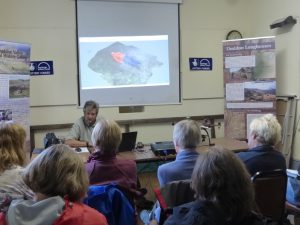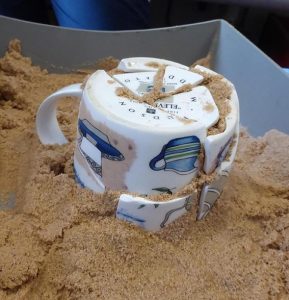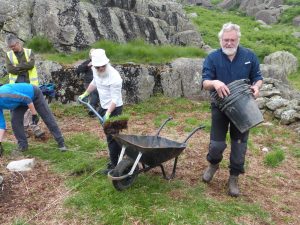Training Day
A week before the dig, twenty six volunteers and five archaeologists turned up at the Parish Rooms and were given a general briefing about the project before being split into groups. During the course of the day each group had a chance to sample each of the four activities. Pete and Hannah were out in the rain with the total station learning the basics of surveying in the field behind the pub. Jeremy had OAN’s box of finds and we were able to handle a range of artefacts from flints, through roman and medieval pottery to a selection of clay pipes. Mairaid had a microscope and slides showing pollen samples while waxing lyrical about the contributions paleobotany was going to make to the dig. Jamie demonstrated how aerial photographs could be rendered into 3D images and produced amazing models of one of the group members from a series of photos he took standing over them as they lay still on the floor. The missing hole in the chest where the computer software couldn’t cope with the rise and fall of breathing, is not going to be a problem on the dig site
Work with schools
As part of the outreach programme, which formed a large element of the Lottery Application, we worked with five local primary schools and one secondary school with an Archaeology Club. The schools had one classroom visit for a day of activities and presentations and a half day visit to the site. They were given an introduction to archaeology and the techniques used and then a more specific look at the medieval period and the occupation of longhouses. Groups were rotated through four activities during the day. They had a chance to handle real objects from OAN’s school collection ranging from flint scrapers through medieval pottery to clay pipes. They excavated modern objects buried in sand trays recording their progress in stages as the sand was scraped away. We made a length of trench, partly drawn and partly made of real objects, which they recorded using planning frames. A number of sieves were used to show how small objects might be missed if the holes were too big. Finally, they had a chance to reconstruct items of broken pottery. It was great to see the cooperation and hear the range of language during the activities.
The site visits had the full range of summer weather but only one of the groups got really soaked. The walk up to the site had a history timeline going back a year for each metre walked with board highlighting the events for each fifty year period. At the site, children took part in different activities looking at the excavation, the surrounding area and drew part of the enclosure walls. Two schools were able to dig in one metre square sections over areas highlighted by the geophysics but no finds were made.
Digging at last
After more bracken clearing, the first sod was cut and the work of sorting out the longhouse began. We cleared the fallen stones to reveal the line of the walls. The bracken rhizomes were monstrous and would lift large stones rather than break when pulled up. Trenches were started where the geophysics had suggested anomalies but the volunteers and the good weather meant that we were able to excavate most of the building and lift sections of the enclosure walls to search for evidence for dating. It was a a big disappointment that lifting the three hearths revealed more bracken rhyzomes but we found two separate layers of cobbled flooring just as we were thinking the bracken had destroyed all evidence. There was no evidence of a drain from the lower section of the building, but drains running across the outside of the higher end and down one side showed clearly how ground water had been kept out of the building. Two pieces of charcoal were found and sent for dating. Samples were taken across the site for further analysis. Two finds, a small horseshoe and a broken knife blade were found in the enclosure area but couldn’t be used for dating evidence. After backfilling the trenches, we planted some grass seed over the site in the hope that the bracken encroachment will be delayed now most of the root system has been dug up
For more detailed day by day accounts and photos, visit the blog at: https://duddondig.wordpress.com
Return to the DuddonDig page...










